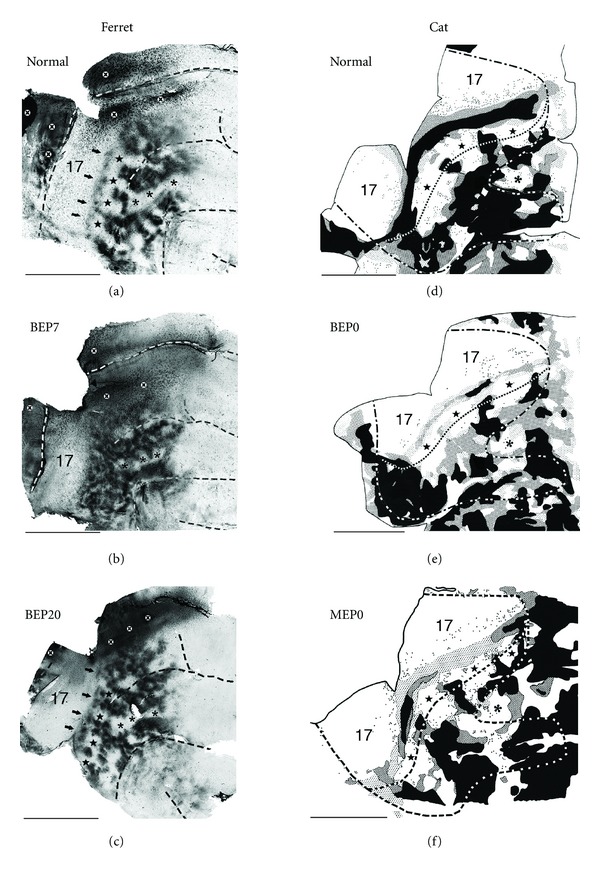Figure 3.

Effects of enucleation on the visual callosal patterns in ferrets and cats. Callosal patterns were revealed on the right hemisphere following multiple intracortical injections of HRP into the left hemisphere. Callosal patterns were reconstructed from several tangential sections cut through the unfolded and flattened cortex (see Figure 2). Posterior is left, dorsal is up. (a, b, c) Visual callosal pattern in normal (a), bilaterally enucleated at postnatal day 7 (BEP7) (b), and bilaterally enucleated at postnatal day 20 (BEP20) (c) ferrets. Dark areas correspond to callosal cell bodies and axonal terminations labeled with HRP reaction product. Dashed lines indicate fundi of sulci. Black stars on the lateral gyrus in (a) and (c) indicate acallosal regions common to all control and BEP20 ferrets. Asterisks on the suprasylvian gyrus indicate acallosal regions common to all control, BEP7, and BEP20 ferrets; black arrows indicate string of callosal patches located in area 18 in control (a) and BEP20 (c) ferrets. Black X's within white circles in (a, b, c) indicate regions of artifactual labeling. (d, e, f) Visual callosal patterns in normal (d), bilaterally enucleated at birth (BEP0) (e), and monocularly enucleated at birth (MEP0) (f) cats. Black regions indicate areas in which the density of labeled cells was highest while dark and light stippling represent areas of decreasing density. Dots represent single labeled cells. The fine dashed line indicates the approximate location of the lateral border of area 18. The lateral border of area 17 (represented by a fine dashed line in Figure 2(d)) is not explicitly marked in (d), (e), and (f) because it approximately runs along the middle of the 17/18 callosal band (the continuous band of callosal connections separating areas 17 and 18). The heavy dashed line corresponds to the outline of visual areas in Figure 2(d). Black stars on the lateral sulcus in (d), (e), and (f) indicate acallosal regions observed in areas 18 and 19 in all control and enucleated cats, and the asterisks on the suprasylvian gyrus indicate acallosal regions common to all control and enucleated cats. Scale bars = 1.0 cm. Adapted from Bock et al. [8]; Olavarria and Van Sluyters [9].
